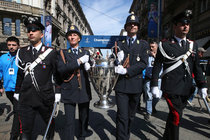By Samindra Kunti in Milan
May 27 – By the end of Saturday night the Champions League trophy will be returning to the Spanish capital as Real Madrid and Atletico Madrid contest club’s football richest game. The winner will bank a cool €15 million; the runner-up €10.5 million. The champions will also earn a ticket to the FIFA World Club Cup in Japan in December, where another €4.5 million is on offer for the winning finalist.
In comparison, Sevilla, winners of this season’s Europa League, cashed only €6.5 million.
The Champions League final is the richest prize in world football. But for the Spanish there is more at stake than just crosstown bragging rights in UEFA’s flagship event at the San Siro in Milan. It is an opportunity for Spanish football’s club brand to stamp real authority over the world football commercial marketplace and challenge the English Premier League’s much coveted international revenues.
The Milan final is a showcase to back up the Spanish boasts that their clubs are the best in the world and that their league is the most exciting and highest quality.
Atletico and Real are no strangers. They played in the 2014 Champions League final in Lisbon where Real prevailed after extra time, 4-1. In this season’s semi-finals Real Madrid eliminated English hopefuls Manchester City 1-0 on aggregate, while Atletico’s 2-2 away draw at Bayern Munich was enough to progress to the final.
The 2016 final is not UEFA’s projected dream final between Bayern Munich and FC Barcelona, instead the match will be a showpiece for La Liga.
Under the presidency of Javier Tebas, La Liga has been campaigning hard to upgrade its global brand image. “It’s the perfect showcase,” Adolfo Bara, La Liga’s general manager for marketing and sales, said in an interview to Bloomberg. “When we are selling La Liga, we are saying we are the best championship in the world.”
In a way, FC Barcelona and Real Madrid held the league back for many years. The behemoths dominated on the pitch, resulting in individual TV deals and club sponsorships. The arch rivals from the Spanish capital and Catalonia enjoyed huge revenues, but the smaller Spanish clubs fell behind with the financial crisis in 2008 aggravating their plight.
Tebas altered that structure, realising that a bi-annual El Classico’s were not enough to build a global brand. This season he has marketed the TV rights as a package with all clubs benefiting from the shared revenue. Barcelona and Madrid still get the lions share, but smaller clubs will bank €40 million on average from TV sales.
For La Liga the next aim is to increase global sponsorship. The league wants a global footprint with a presence in at least 80 countries.
La Liga still has a long way to go if it wants to match, or even outdo, the Premier League as the world’s leading league. The English league is drowning in money after a record-breaking television rights deal, worth about £2.7 billion per year, more than double the value of La Liga’s TV rights.
Part of Tebas’s strategy is to break into the big, money-spinning Chinese market. The Champions League final may help with that. The winner will get a ticket to the 2016 FIFA Club World Cup in Japan, another marketing opportunity in the Far East. The winner of that competition will earn another €4.5 million.
But can La Liga match the Premier League in terms of entertainment value? The all-Milan final will certainly serve as a good benchmark.
The rivalry pits Zinedine Zidane, novice coach in the Spanish capital, against his Argentine counterpart Diego Simeone, nicknamed El Cholo. Both have very different philosophies, reflecting of the different playing styles during their own careers. Zidane wants his team to play forward-minded football, based on possession, but Madrid have so far only played power football under his stewardship. Simeone is far less expansive. His hyper-defensive approach is pragmatic, hitting opponents on the break.
Atletico are a testament to a the growing strength in-depth within Spanish club football and potential of Spanish football. Simeone’s achievement of keeping Atletico at the top is Herculean. After the 2014 Champions League final Atletico sold a number of key players, including Thibaut Courtois and Diego Costa. The Argentinean coach has rebuilt his team, not so much so through Atletico’s modest means, but rather by sticking to his mantra: drilling his players with much rigor and resilience. Simeone cares little about entertaining – for him, all that matters is winning.
La Liga’s Tebas wants the same. But he wants some style to come with it, to bring a new fashion to world football, starting in one of the world’s fashion capitals.
Contact the writer of this story at moc.l1751419726labto1751419726ofdlr1751419726owedi1751419726sni@i1751419726tnuk.1751419726ardni1751419726mas1751419726

